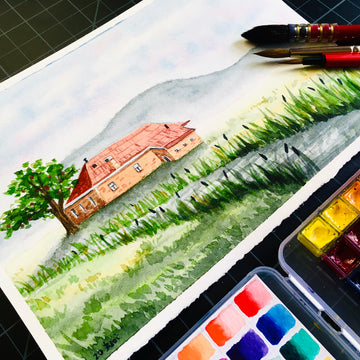Most people have probably seen, if not used, some sort of easel before. Whether it’s to prop up that beautiful wedding photo at a reception, or for holding your canvas in place during art class, its original function is to keep artwork upright while you work on your painting.
For media like acrylic or oil paints, this is often for accommodating the size of the canvas, making it easier to stand up and paint, or at the very least preventing a bad crick from forming in your neck!
Watercolour is an especially fluid medium, so you can actually make use of gravity as a tool for painting! Let's take a look at how.
A Few Tools

First off, you don’t technically need an easel (yes, really!). What you do need is to tape a good quality watercolour paper to some sort of hard board so it can remain flat while you tilt the painting about.
The paper also needs to be thick enough to hold a good amount of water – at least 300gsm. I’d also recommend 100% cotton paper, as the cotton helps distribute the pigments more evenly to create really smooth blends.
Taping the edges of your watercolour sketchbook or pad works too (if your sketchbook/pad has a hard cover like the Etchr Sketchbooks). Alternatively, you can skip all that and use a watercolour paper block, which already has sealed edges that keeps your paper flat and sturdy.
Another option is you can use something that props your paper at a gentle angle. I like using my roll of artist’s tape – it’s heavy enough to not move around while I paint, and it’s not too tall.
Of course, if you do have an easel, you can use that instead! Just make sure you’re able to secure your board/sketchbook properly before painting.
Painting with Gravity

Using the wet-in-wet technique is a great way to showcase the effects of gravity. This means wetting the area you need to paint with clean water before dropping in wet paint on top.
You’ll see the paint pigments slowly move in the direction tilting downwards, which creates very natural-looking gradients. It’s good for making a foggy or misty atmosphere, too!
As you can see in the painting above, I’ve created a misty background by wetting the mountain area with water before adding a dark green at the top, then tilted my board so the paint faded downwards towards the horizon line which gives it an “early morning” feel.
Bonus tip: If you swap the gradient around so more pigment is added towards the horizon line, you would create the illusion of rain.

Another fun thing to do is to pick up your board/sketchbook/pad and tilt it in a different direction before the paint dries. You can also experiment with using more water, less water, or blending different colours and see how gravity affects your paint!
Note: Try not to use too little water, as this will prevent the paint from flowing.
I’ve done a bit of that with the grassy field in this painting. This helps to make it stand out from the background atmosphere, and give it a sense of direction (so the grass looks like its growing upwards).
Final Thoughts

Watercolour is a great medium to learn how to exercise freedom within control, since using gravity means you need to allow the watercolour to do its own thing, although you can still control its general direction. And sometimes, the best paintings are born from what we may think are “mistakes”!
So have fun with this invisible force we call gravity, and don’t be afraid to make those mistakes, since who knows - they could turn into your greatest masterpiece yet!
Have you tried painting with gravity before? If so, what kind of effects did you use it for? Let us know in the comments below!


